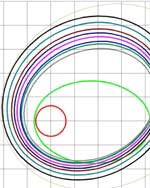
Image credit: ESA
The European Space Agency’s SMART-1 spacecraft has completed its 176th orbit around the Earth, finally reaching the outer limits of our planet’s Van Allen radiation belts. After weeks in the intense radiation, it looks like everything on SMART-1 is functioning normally. The spacecraft has fired its ion thruster for a total of 1,500 hours and only consumed 24 kg of Xenon fuel. SMART-1 is taking the slow road to the Moon, where it will map the surface and search for deposits of ice.
The spacecraft is now in its 176th orbit, in good status and with all functions performing nominally. The first mission target, namely to exit the most dangerous part of the radiation belts, has been achieved! The pericentre altitude (the closest distance of the spacecraft from the centre of the Earth) will reach the prelaunch target of 20 000 km on 7 January 2004.
Between 23 December 2003 and 2 January 2004, the thruster fired continuously for a record duration of more than 240 hours. This is likely to remain the record for some time because later this week SMART-1 will change from a continuous thrust strategy to a more orbitally efficient thrust arcing.
The total cumulated thrust so far of more than 1500 hours, consuming 24 kg of Xenon, has provided a velocity increment of about 1070 ms-1 (equivalent to 3850 km per hour). The electric propulsion engine’s performance, periodically monitored by means of the telemetry data transmitted by the spacecraft and by radio-tracking by the ground stations, continues to show a small over performance in thrust: varying from 1.1% to 1.5% over the last week.
The degradation of the electrical power produced by the solar arrays has now ceased. The power available has remained virtually constant since November 2003.
The communication, data handling, on-board software and thermal subsystems have been performing well in this period.
Original Source: ESA News Release
